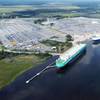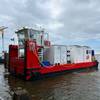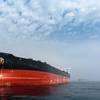Managers of Jamaica's delayed Port Royal Development Project expect to begin construction by year-end on a cruise ship pier central to the restoration of the one-time "wickedest city on earth." The Caribbean port earned the dubious distinction in the 17th century, when buccaneer Henry Morgan ruled the waves and made Port Royal his base.
The infamy did not last long, as much of Port Royal disappeared under the sea in a massive earthquake in 1692. Another earthquake in 1907 did further damage, leaving only a small village at the end of Jamaica's Palisadoes Peninsular, just east of the capital Kingston. Prime Minister P.J Patterson has described the pier project as "one of the most ambitious and promising tourism developments ever undertaken in Jamaica."
Originally dubbed the Millennium Plan, it was to have been ready to receive cruise ships in June 2000, but was thrown off target by logistic difficulties. Robert Stevens, managing director of the project, said he now expects to begin construction of the cruise ship pier in late 2000.
The developers need to raise $60 million for the first phase of the project, which will include construction of restaurants, museums and shopping facilities on the Peninsular, near the Norman Manley International Airport.
"In March we'll be finishing all the documents with Citibank and we expect to be in the marketplace by April. If everything goes according to schedule, then before the end of the second quarter, we should be able to identify the equity investors and then be able to begin construction before the end of this year," Stevens said. Eventually the project will incorporate a theme park designed to transport visitors back to the buccaneer era. Phases two and three could take the cost up to $200 million, Stevens said. His optimism for the project was buoyed in part by recent sonar studies of the ocean floor, which confirmed the site was appropriate for the pier, "with the depths just offshore being about 35 ft. (10.6 m) going out to about 60 ft. (18.2 m)." Stevens said the sonar testing clearly identified the boundaries of the sunken city. "We've also been able to identify anomalies that occur out there, where there may be sunken ships or buildings," he said.
Despite the delay, the Jamaican government has taken a deeper interest in the project, using the Urban Development Corporation (UDC) to inject new life into the plan, government spokeswoman Maxine Henry Wilson said.
The project is one of a several major development plans that the government is leading or lending support to in its effort to kick-start the stagnant economy and fuel long-term economic growth. The prime minister recently announced plans for a major highway network to open up the interior of the island and spur development of light industry and tourism projects along its span. He also disclosed plans for an air cargo transshipment facility on Jamaica's south coast, along with several tourism and information technology projects.
But the Port Royal project remains a sentimental favorite for some in the government and for Stevens, who said the restored port would serve as a gateway for a whole gamut of heritage tourist attractions. On Feb. 6 - Bob Marley Day in Jamaica - the Trench Town Culture Yard was officially opened in Kingston. The yard, which is incomplete, incorporates several historically significant buildings including the house where the late reggae superstar spent many of his formative years and began his meteoric rise to international stardom. Stevens said the Culture Yard would be an important stop for many of the 5,000 cruise ship passengers expected to disembark in Port Royal each week.
Subscribe for
Maritime Reporter E-News
Maritime Reporter E-News is the maritime industry's largest circulation and most authoritative ENews Service, delivered to your Email five times per week










